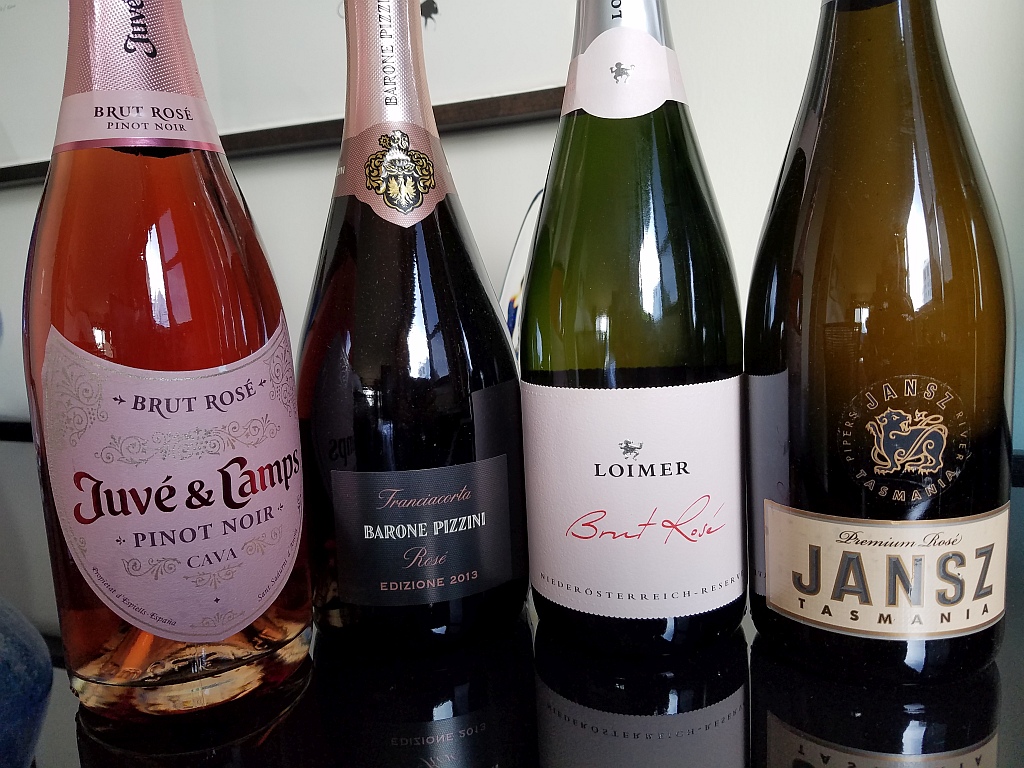Rose’ Champagne and other sparkling wines make their splash every February 14. My restaurant years taught me that those wines—a symbol of giddy celebration—are more smiled at than savored, and flirted over than studied. In nod to this annual rite of romance, today’s article offers a selection of these pinkish bubbly wines.
The rose color of Champagne and sparkling wines is created by either adding pinot noir still wine before the second fermentation—the process that creates the bubbles—or, by steeping the skins of pinot noir and/or pinot meunier in the juice before the first fermentation is started. Most producers use the first method as it gives them greater control over the outcome.
The nonvintage Juve & Camps Brut Rose’ is pure pinot noir made in the Penedes, the region famous for Spain’s Cava sparkling wines. Cava’s regulations stipulate the wines be made using the classic method of Champagne. Juve & Camps brilliant red color, pleasing cherry and strawberry aromas, and ripe, red-fruit flavors will make this bubbly twice enjoyable when you pay its non-Champagne price. 87 points. Retail prices start at $11.49 and climb to a ridiculous $25. Good value is found at less than $16.
Austria is not a country known for sparkling wines, but you’ll want to get to know the nonvintage Loimer Brut Rose’ Reserve. In 1988, Fred Loimer joined his father at the family’s wine estate after working at wineries in Germany and at Walter Schug winery in Sonoma. Nine years later, he took full control of the winery. In 2006, he began farming the vineyards biodynamically, gaining certification by Respekt, the Austrian biodynamic viticulture association.
The brut rose’ reserve is a blend of three red grapes: zweigelt, pinot noir and St. Laurent grown in silt, rocky and limestone soils. Fermented with indigenous yeasts, the wine follows the traditional method and is aged 18 months in the bottle. The result is an orange-tinted sparkling wine with a gravelly aroma and cherry flavor that finishes in a dry, mineral-accented nectarine tang. With only two grams of residual sugar, Loimer’s brut rose meets the Champagne definition of extra brut, and its quality matches many of those wines, while its price does not. 92 points. Retail is $26 to $36.
Better known is Franciacorta, the Italian sparkling wine region in Lombardy. From there comes the 2013 Barone Pizzini Rose’ Franciacorta. While sparkling wine in the Franciacorta area was written about in the late 16th century, the area gained appellation status only in 1967, and Barone Pizzini marketed its first Franciacorta sparkler in 1971.
The 2013 Barone Pizzini rose’ is made with 80% pinot noir and 20% chardonnay. After its alcohol fermentation, the wine is aged in French oak barrels for one year, then aged in bottle for approximately three years. This classic winemaking yields croissant and cherry aromas, a rich, round texture carrying strawberry-like flavor with a dry, fruit-filled finish. At only five grams of residual sugar, the 2013 Barone Pizzini meets the Champagne definition of extra brut (not more than six grams of sugar per liter), but it is more fruit-driven and rounder than many extra brut Champagnes. 90 points. Expect to pay about $27 to $40.
Some years ago, while in Australia, I flew to Tasmania from Victoria, to explore its wines. I experienced its cool climate and affinity for sparkling wines. One of my visits was to Jansz, a winery founded in 1975. It partnered with the prestigious Champagne house Louis Roederer in 1986; 11 years later, Jansz was purchased by the Hill-Smith family. The relationship with Roederer ended and the winemaking method changed its name from Methode Champenoise to Methode Tasmanoise. But no matter the name, the process remains the same: alcoholic fermentation followed by a second fermentation in the bottle.
The nonvintage Jansz Rose’ Tasmania is 78% pinot noir and 22% chardonnay. It is faintly copper-tinted with a mildly sweet, white-chocolate aroma. Its soft texture offers a mellow, perhaps modest, taste of cherry flavor and carries eight grams of sugar. This is a “Goldilocks” sparkling wine for those who would find the Juve & Camps too fruity, the Loimer too dry and tart, and the Barone Pizzini too full. 85 points. Retail prices range $20 to $30.
In December, I tasted the delightful nonvintage Alfred Gratien Cuvee Paradis Rose’ at the annual holiday Champagne luncheon of the New York-based Wine Media Guild.
Alfred Gratien Champagne was founded in 1864. In 2000, it was sold to the Oetker family. For the last four generations, the cellar master (as the winemaker is called in Champagne) has been passed down from father to son. Today 47-year-old Nicolas Jaeger is the cellar master for this excellent grower-Champagne house.
Made with 63% chardonnay and 37% pinot noir, the nonvintage Cuvee Paradis rose is Alfred Gratien’s prestige cuvee, and unusual in that it is nonvintage (the only other nonvintage prestige cuvee I can recall is Laurent-Perrier’s Grand Siècle).
Another unusual aspect of Alfred Gratien Champagne is its absence of malolactic fermentation in the winemaking process. Not using this technique preserved the wine’s natural acidity giving it an energetic boost to its cherry and strawberry-like aromas and tart cherry and watermelon tastes of grapes selected exclusively from grand cru vineyards.
Its creamy texture results from its vinification in small French oak barrels and the long, pleasing finish is a statement about its seven years of bottle aging. This superb Champagne will make the smiles broader and the flirtation longer. 94 points. Retail price is $98 to $110.
Happy Valentine’s Day.
Photos by John Foy










Leave A Comment